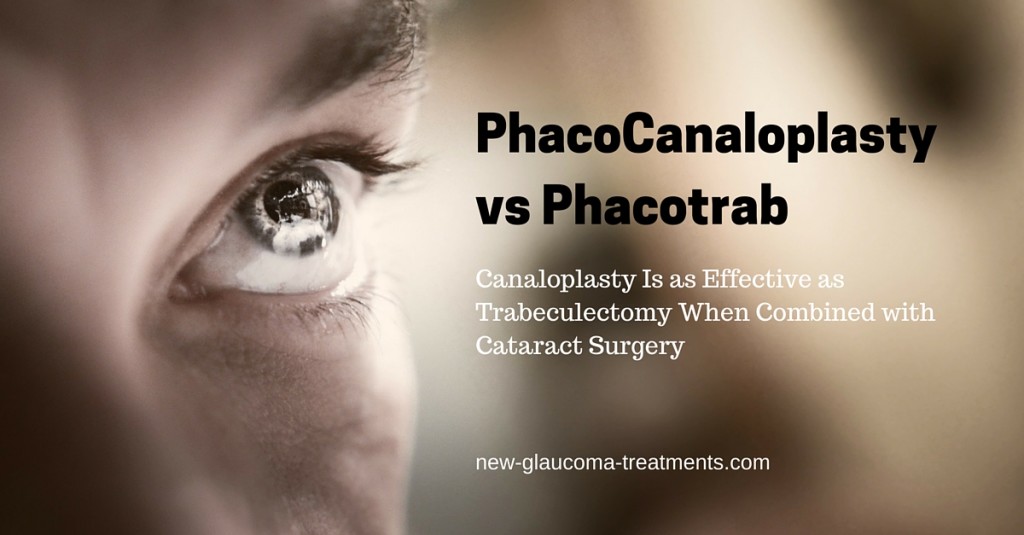
Canaloplasty Is as Effective as Trabeculectomy When Combined with Cataract Surgery
Unlike with trabeculectomy, cataract surgery enhances the IOP lowering effect of canaloplasty.[1] A recent study comparing the results of combined cataract and glaucoma surgery (”phacotrabeculectomy” vs. “phacocanaloplasty”) was published in the Journal of Glaucoma.[2] One year after surgery, participants who underwent phacocanaloplasty had IOPs that were not significantly higher than those who underwent phaco-trabeculectomy. The median percent reduction in IOP was greater after phaco-trabeculectomy (40%) versus phacocanaloplasty (28%). However, this may have been due to higher initial IOP in the phacotrabeculectomy group.
Final glaucoma medication use as well as failure rate was similar in both groups. Over 60% of study patients in both groups were off all glaucoma drops one year after surgery. Although final vision was similar in both groups, those who underwent phacocanaloplasty experienced faster improvement of vision compared to those who underwent phaco-trabeculectomy glaucoma surgery.
No patients in the phacocanaloplasty group experienced the feared complications of hypotony or associated loss of vision from hypotony maculopathy. Indeed, the authors of the study go on to state that, “We have seen neither hypotony maculopathy nor suprachoroidal effusions/hemorrhage so far after canaloplasty in our experience. This is a distinct advantage of the canalbased surgery as also is the absence of a bleb and bleb-related problems such as infections and discomfort.”
References
- Lewis RA, von Wolff K, Tetz M, et al. Canaloplasty: threeyear results of circumferential viscodilation and tensioning of Schlemm canal using a microcatheter to treat openangle glaucoma. J Cat Ref Surg. 2011;37(4):682690.
- Schoenberg ED, Chaudhry AL, Chod R, Zurakowski D, Ayyala RS. Comparison of Surgical Outcomes Between Phacocanaloplasty and Phacotrabeculectomy at 12 Months’ Followup: A Longitudinal Cohort Study. J Glaucoma. 2015;24(7):543549.
Don’t delay getting checked for glaucoma.
Make an appointment with an eye doctor in your area now. If you live in the greater Los Angeles area and would like Dr. Richardson to evaluate your eyes for glaucoma call 626-289-7856 now. No referral required. Appointments are available, Tuesday through Saturday.
In The Same Series:
- Trabeculectomy Surgery For Glaucoma
- Why Trabeculectomy is the Most Common Glaucoma Surgery
- Risks of Trabeculectomy (Part 1 of 2)
- Risks of Trabeculectomy (Part 2 of 2)
- When Should Trabeculectomy Be Considered?
Related Articles:
- What Is The Big Deal About A Bleb?
- Is Trabeculectomy an Option After Canaloplasty?
- PhacoCanaloplasty™ vs Phacotrab
- 1 in 5 Trabeculectomy Patients May End up With Ptosis (Eyelid Droop)
- Trabeculectomy versus Canaloplasty (TVC study)
- Trabeculectomy Glaucoma Surgery After Canaloplasty
- Trabeculectomy Glaucoma Surgery (Part 3 of 12 of “What’s New In Glaucoma Surgery” Presentation)

David Richardson, MD
Medical Director, San Marino Eye
David Richardson, M.D. is recognized as one of the top cataract and glaucoma surgeons in the US and is among an elite group of glaucoma surgeons in the country performing the highly specialized canaloplasty procedure. Morever, Dr. Richardson is one of only a few surgeons in the greater Los Angeles area that performs MicroPulse P3™ "Cyclophotocoagulation" (MP3) glaucoma laser surgery. Dr. Richardson graduated Magna Cum Laude from the University of Southern California and earned his Medical Degree from Harvard Medical School. He completed his ophthalmology residency at the LAC+USC Medical Center/ Doheny Eye Institute. Dr. Richardson is also an Ambassador of Glaucoma Research Foundation.


